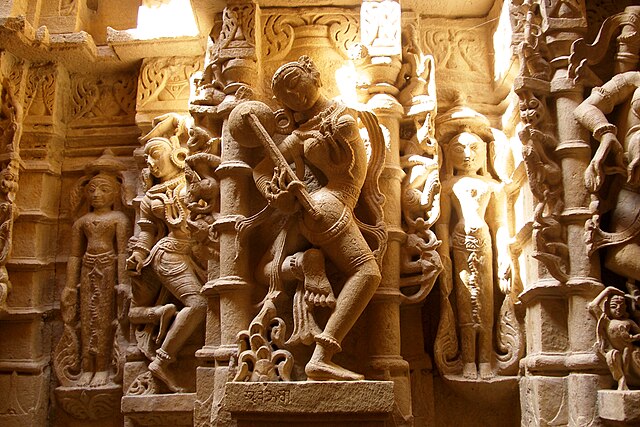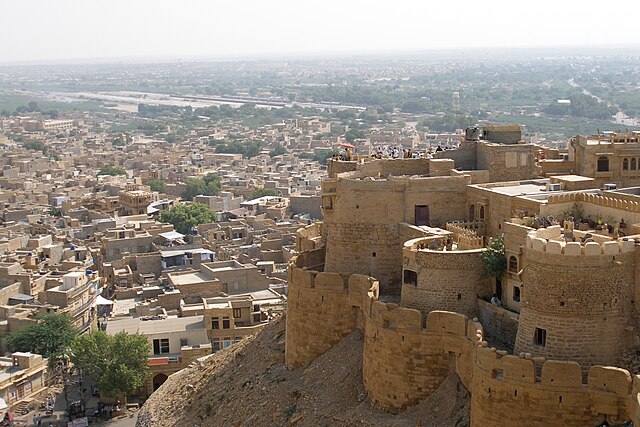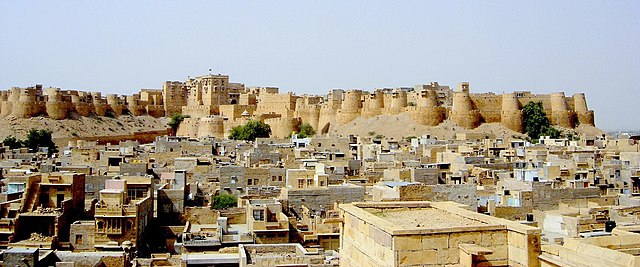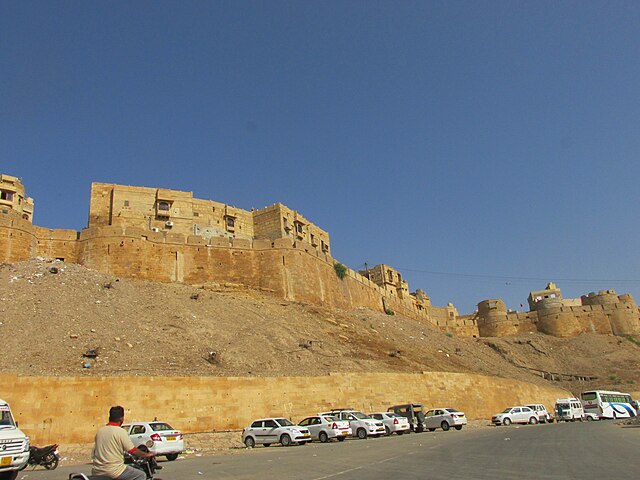Imagine a fortress rising like a golden mirage from the sands of the Thar Desert, its walls glowing under the Rajasthani sun. That’s Jaisalmer Fort, a living, breathing monument that’s more than just stone and history—it’s the soul of Jaisalmer. Known as Sonar Quila, or the Golden Fort, this UNESCO World Heritage Site is one of India’s rare living forts, where people still live, work, and celebrate life. Built in 1156 CE, it’s a maze of narrow lanes, ornate palaces, and ancient temples that tell tales of Rajput valor and desert dreams. Ready to step into this golden wonder? Let’s explore why Jaisalmer Fort is a must-see for every traveler!
Why Jaisalmer Fort Steals the Show
Jaisalmer Fort isn’t your typical tourist spot—it’s a time capsule that pulses with life. Unlike most forts that stand as silent relics, this one is home to thousands of people, with bustling markets, cozy cafes, and sacred temples tucked into its golden walls. Its sandstone architecture blends so perfectly with the desert that it feels like the fort grew out of the sand itself. Whether you’re a history nerd, an architecture lover, or just someone chasing Instagram-worthy views, Jaisalmer Fort has something to make your heart skip a beat. Can you picture yourself wandering through a 900-year-old fortress that’s still alive?
A Peek into the Fort’s Rich History
Jaisalmer Fort was born in 1156 CE, when Rawal Jaisal, a Bhati Rajput king, decided to build a stronghold in the heart of the Thar Desert. Strategically perched on Trikuta Hill, it became a key player on the Silk Route, a bustling trade path connecting India to Central Asia. Merchants, warriors, and travelers passed through, enriching the fort with culture and wealth. Over centuries, it withstood invasions, sieges, and the harsh desert climate, standing tall as a symbol of resilience. Today, it’s a living testament to Jaisalmer’s golden past, inviting you to walk in the footsteps of kings and traders.
The Bhati Rajputs: Keepers of the Fort
The Bhati Rajputs are the backbone of Jaisalmer Fort’s story. These fierce warriors didn’t just build the fort—they gave it a soul. Their legacy lives in the fort’s grand architecture, from its towering gates to its intricate palaces. Think of them as the desert’s architects and guardians, blending courage with creativity to create a fortress that’s both a shield and a masterpiece. Their influence still echoes in the fort’s festivals, music, and the proud spirit of its residents.
The Golden Architecture of Jaisalmer Fort

Jaisalmer Fort is like a love letter written in sandstone. Its golden-yellow walls, carved from local stone, shimmer in the sunlight, earning it the nickname Sonar Quila. The fort’s design is a blend of Rajput and Islamic styles, with delicate jharokhas (balconies), arched gateways, and intricate latticework that look like they were crafted by magic. Spanning 1,500 feet long and 750 feet wide, it’s a massive structure that feels both grand and intimate. Ever wondered what it’s like to explore a fort that looks like it’s made of gold?
The Four Grand Gateways
Entering Jaisalmer Fort is like stepping through a portal to another era. The fort has four massive gateways—Akshya Pol, Ganesh Pol, Suraj Pol, and Hawa Pol—each one a work of art. Suraj Pol, or the Sun Gate, faces east, catching the first rays of dawn and bathing the fort in golden light. Hawa Pol, the Gate of Wind, is adorned with carvings so delicate they seem to dance in the breeze. These gates aren’t just entrances; they’re storytellers, whispering tales of royal processions and ancient battles.
Defensive Design: A Fortress Built to Last
Jaisalmer Fort wasn’t just built for beauty—it was a fortress meant to survive. Its three layers of walls, interspersed with 99 bastions, made it nearly impregnable. The fort’s elevated position on Trikuta Hill gave it a commanding view of the desert, perfect for spotting invaders. Narrow, winding lanes inside were designed to confuse enemies, while hidden passages offered escape routes. It’s like a giant puzzle, blending brains and brawn to keep its people safe for centuries.
Jain Temples: Spiritual Jewels of the Fort
Tucked inside Jaisalmer Fort are seven Jain temples, each one a masterpiece of spirituality and art. Built between the 12th and 15th centuries, these temples are dedicated to Jain Tirthankaras, with intricate carvings that rival the finest jewelry. Step inside, and you’re greeted by pillars, domes, and walls etched with stories of devotion. The air feels sacred, yet welcoming, as if the temples are inviting you to pause and reflect. Can you imagine praying in a place that’s been holy for nearly a millennium?
Highlights of the Jain Temples
The Jain temples are a feast for the senses. The Parsvanath Temple, the oldest of the seven, boasts a stunning black marble idol and ceilings carved with celestial figures. The Chandraprabhu Temple dazzles with its mirrorwork and delicate stone lattice. Every temple feels like a gallery of ancient art, with sculptures so detailed they seem to come alive. These aren’t just places of worship—they’re a window into Jaisalmer’s pluralistic past, where Jainism flourished alongside Rajput culture.
Preserving the Temples’ Legacy
Keeping these temples pristine is no small feat. Local Jain communities and heritage organizations work tirelessly to maintain their intricate carvings and sacred spaces. Visitors are asked to remove shoes and avoid photography inside to respect their sanctity. It’s a reminder that Jaisalmer Fort isn’t just a tourist attraction—it’s a living heritage site where faith and history coexist. By visiting respectfully, you’re helping preserve these spiritual gems for future generations.
Raj Mahal: The Royal Palace Within

The Raj Mahal, or Royal Palace, is Jaisalmer Fort’s crown jewel. Once home to the Bhati kings, it’s now a museum that takes you inside the lives of royalty. Picture mirrored halls, painted ceilings, and jharokhas offering sweeping views of the desert. The throne room, with its ornate arches, feels like a stage where history unfolded. Wandering through, you can almost hear the clink of royal jewelry and the murmur of courtly intrigue. It’s like stepping into a Rajasthani fairy tale.
Stories from the Royal Chambers
Every room in the Raj Mahal has a story to tell. The queen’s chambers, adorned with delicate frescoes, hint at the elegance of royal women. The king’s audience hall, with its carved pillars, was where decisions shaped Jaisalmer’s fate. Exhibits display artifacts like royal costumes, weapons, and manuscripts, bringing the past to life. Don’t miss the rooftop terrace—it’s the perfect spot to soak in the fort’s golden glow and imagine life as a desert king.
Life Inside a Living Fort
What makes Jaisalmer Fort truly unique is that it’s still alive. About a quarter of Jaisalmer’s population lives inside its walls, running shops, cafes, and guesthouses. Narrow lanes buzz with kids playing, vendors hawking spices, and artisans crafting leather goods. It’s like a small town frozen in time, where medieval architecture meets modern life. Ever stayed in a hotel inside a 900-year-old fort? In Jaisalmer, you can!
The Fort’s Vibrant Markets
The markets inside Jaisalmer Fort are a treasure hunt waiting to happen. Stalls line the cobbled lanes, selling everything from Rajasthani textiles to silver jewelry. You’ll find mirrorwork bags, embroidered shawls, and miniature paintings that capture the fort’s golden charm. Haggling is part of the fun, so channel your inner negotiator. Grab a cup of masala chai from a tiny cafe and watch the world go by—it’s the perfect way to soak up the fort’s lively vibe.
Challenges of Preserving Jaisalmer Fort
Keeping a living fort intact is like trying to preserve a sandcastle in a storm. Jaisalmer Fort faces challenges like water seepage, overcrowding, and the wear and tear of tourism. The fort’s ancient drainage system struggles with modern demands, causing damage to its foundations. Local authorities and UNESCO are working on conservation efforts, but it’s a delicate balance between preserving history and supporting the fort’s residents. As a visitor, choosing eco-friendly stays and respecting guidelines helps keep this golden wonder standing tall.
Conservation Efforts and Visitor Responsibility
Conservation groups are stepping up to save Jaisalmer Fort. Projects focus on strengthening its walls, repairing temples, and upgrading drainage systems. Visitors play a big role too—sticking to designated paths, avoiding litter, and supporting local businesses help sustain the fort. Think of it like visiting a friend’s ancient home: you want to leave it as beautiful as you found it. By traveling responsibly, you’re helping ensure Jaisalmer Fort shines for centuries to come.
Experiencing Jaisalmer Fort: Tips for Visitors

Planning a trip to Jaisalmer Fort? You’re in for a treat! The best time to visit is October to March, when the desert’s heat is manageable. Wear comfy shoes for the fort’s cobbled lanes, and carry water to stay hydrated. Hiring a local guide is a game-changer—they’ll share stories that bring the fort to life. Don’t miss sunrise from the ramparts; it’s like watching the desert wake up in a blaze of gold. Ready to make your visit unforgettable?
Top Activities Inside the Fort
Jaisalmer Fort is packed with things to do. Start with a guided tour of the Jain temples and Raj Mahal. Then, wander the markets, picking up souvenirs like camel leather journals. For a break, sip lassi at a rooftop cafe with views of the desert. Photography buffs will love capturing the fort’s golden hues at sunset. And if you’re feeling adventurous, book a heritage stay inside the fort—it’s like sleeping in a piece of history.
Cultural Events and Festivals
Jaisalmer Fort comes alive during festivals, when its lanes fill with music and color. The Desert Festival in February spills into the fort, with folk performances and cultural shows. Diwali sees the fort glowing with oil lamps, while Holi paints its walls with vibrant powders. These events offer a glimpse into Rajasthan’s soul, blending tradition with joy. Ever danced to Rajasthani folk music inside a golden fort? It’s an experience you’ll carry forever.
Conclusion
Jaisalmer Fort isn’t just a monument—it’s a golden thread weaving together history, culture, and human spirit. From its shimmering sandstone walls to its sacred Jain temples, every corner tells a story of resilience and beauty. Whether you’re exploring the Raj Mahal, bargaining in its markets, or simply soaking in its desert views, the fort feels like a warm embrace from the past. So, pack your curiosity and head to Jaisalmer Fort—it’s a journey that’ll leave you spellbound and dreaming of golden sands.
FAQs
1. What is the best time to visit Jaisalmer Fort?
Visit between October and March for pleasant weather, ideal for exploring the fort’s lanes and ramparts.
2. Is there an entry fee for Jaisalmer Fort?
Entry to the fort is free, but there’s a small fee for the Raj Mahal museum and camera use in some areas.
3. Can I stay inside Jaisalmer Fort?
Yes! The fort has heritage hotels and guesthouses offering unique stays within its historic walls.
4. Are the Jain temples open to non-Jains?
Yes, but visitors must remove shoes, dress modestly, and avoid photography to respect the sacred spaces.
5. How long does it take to explore Jaisalmer Fort?
Plan for 3-4 hours to explore the fort’s key sites, though you could easily spend a day soaking up its vibe.

